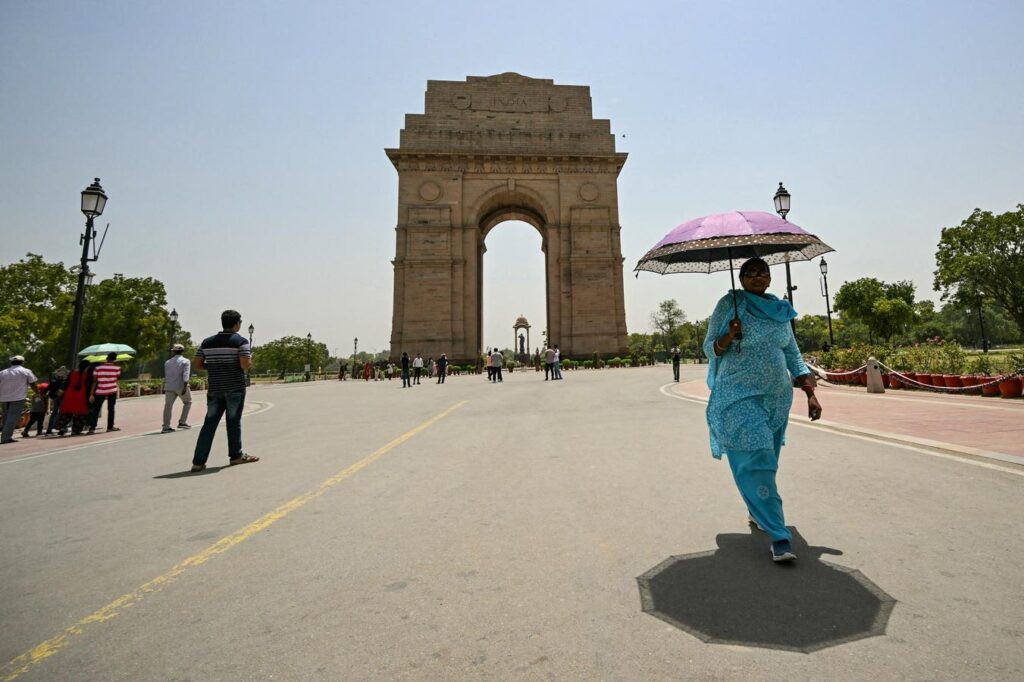Record-Breaking Heatwave Hits New Delhi: A Glimpse into India’s Fiery Future
A severe heatwave has gripped New Delhi, with temperatures soaring to an unprecedented 49.9°C (121.8°F) on May 29, 2024, leaving residents reeling and authorities grappling with warnings of water shortages. As a woman walks near the iconic India Gate, umbrella in hand, the scene underscores a rising crisis that eerily mirrors the dystopian world envisioned by Kim Stanley Robinson in his climate fiction novel The Ministry for the Future. In Robinson’s narrative, a blistering heatwave spells disaster for millions in India, a grim fiction that is now becoming a stark reality.
The Toll of Scorching Summers
This year’s sweltering heatwave has already claimed an estimated 100 lives and resulted in a staggering 40,000 suspected heatstroke cases. However, these figures may only scratch the surface. Public health expert Dileep Mavalankar warns of methodological shortcomings in how Indian health authorities track heat-related illnesses and mortality. This suggests that the actual death toll is likely higher, amplifying the urgency to understand and address the societal and economic repercussions of India’s intensifying summers.
Global and Local Context
India is not alone in facing record-breaking heat. Last month, Saudi Arabia reported 1,400 deaths during the annual pilgrimage in Mecca, where temperatures soared to a scorching 51.8°C. However, India’s challenge is uniquely daunting given its vast population density, both urban and rural, and its infrastructure, which is more tailored to economic growth than adapting to escalating temperatures.
While affluent sections of India’s cities may seem immune to the crisis—benefiting from air-conditioned homes, offices, and malls—the reality is starkly different for the urban poor and rural populace. In these areas, air conditioning is a luxury, and securing water often involves paying private suppliers, exacerbating the financial strain on already vulnerable communities.
Media and Electoral Reflections
Mainstream Indian media often skews towards elite concerns, sidelining pressing issues like climate change and heat stress. Prior to the recent elections, media narratives were overwhelmingly positive, focusing on India’s status as the fastest-growing economy in the G20. This optimism was in stark contrast to the actual voter sentiment, which led to the ruling Bharatiya Janata Party (BJP) losing its majority, as millions cast protest votes driven by lack of economic opportunities and essential resources like water.
The Way Forward
Addressing this growing crisis calls for improved public communication and education—a strategy where the government has notably fallen short. "If the government is not advertising, how will people know what to do? We’ve been breaking heat records every year since 2022. Unless we take action now, it will only get worse," Mavalankar told The Times of India.
India must integrate economic and climate models more effectively to counter the threat of heat stress, particularly as it undermines the country’s potential demographic dividend. While significant focus has been placed on mitigation—reducing emissions and increasing renewable energy investments—an even greater emphasis on adaptation is essential. This includes building climate resilience and investing in public health infrastructure to withstand the harsh realities of a hotter future.
As we confront this unfolding crisis, it becomes clear that Robinson’s climate fiction is no longer a distant warning but a pressing real-world challenge. The time for India to act is now, ensuring the nation’s survival and prosperity in an era of unprecedented heat.
